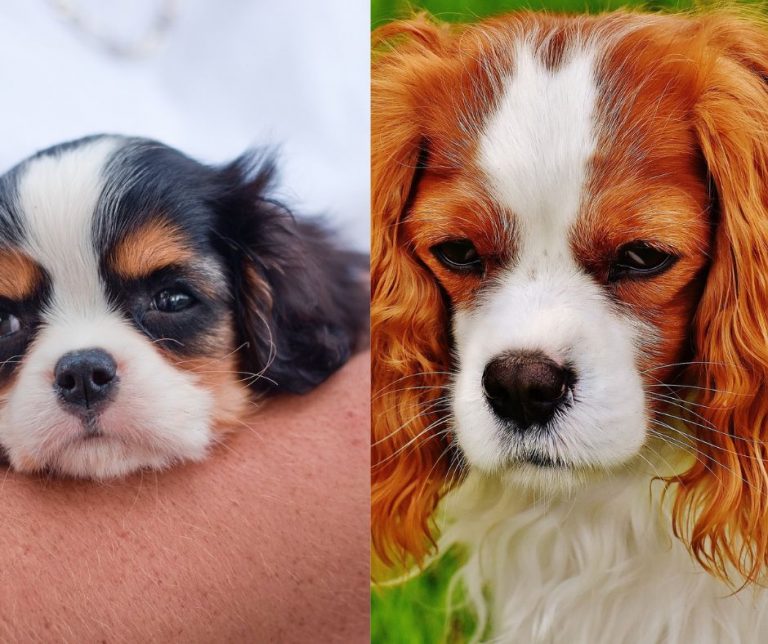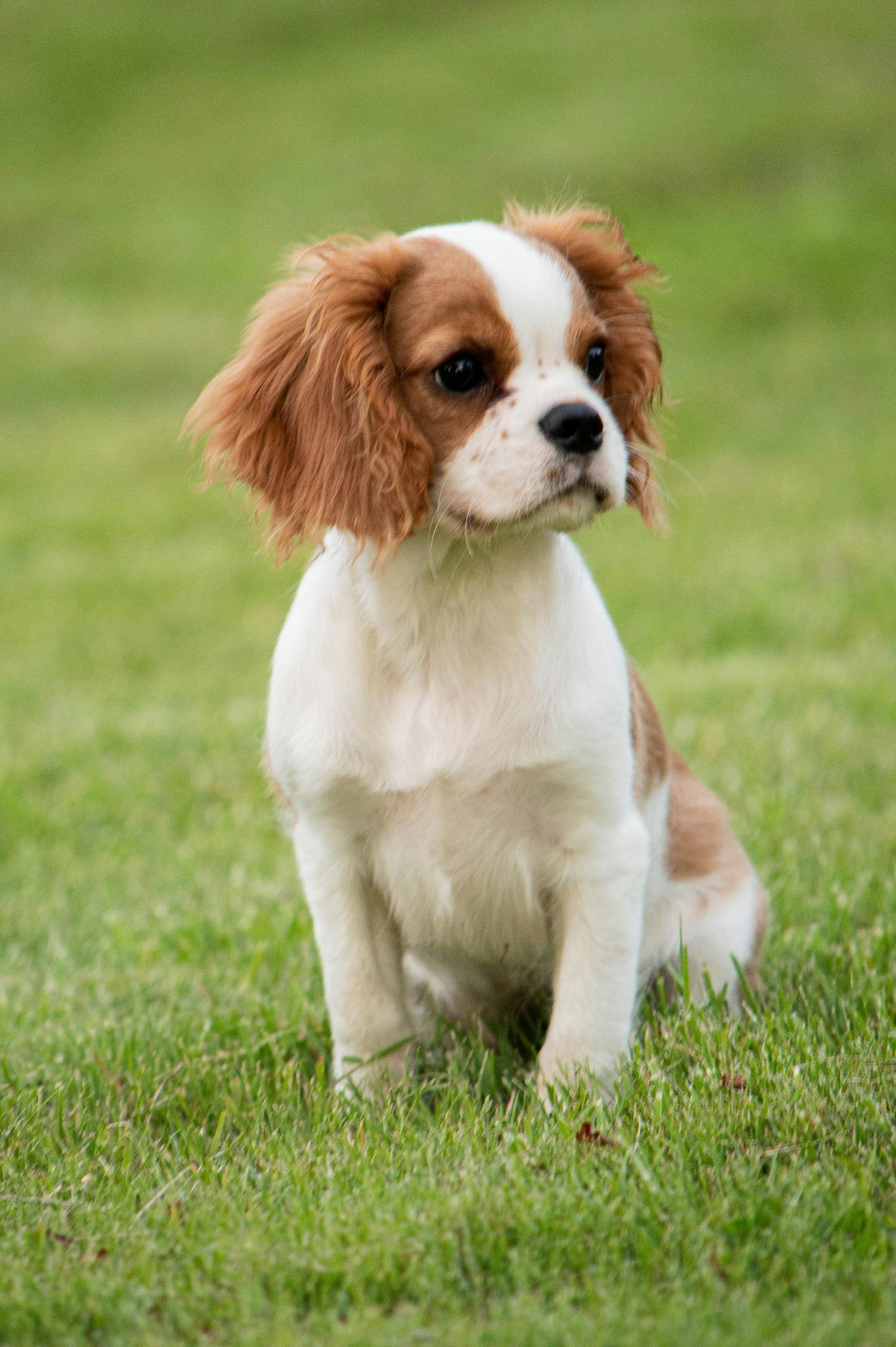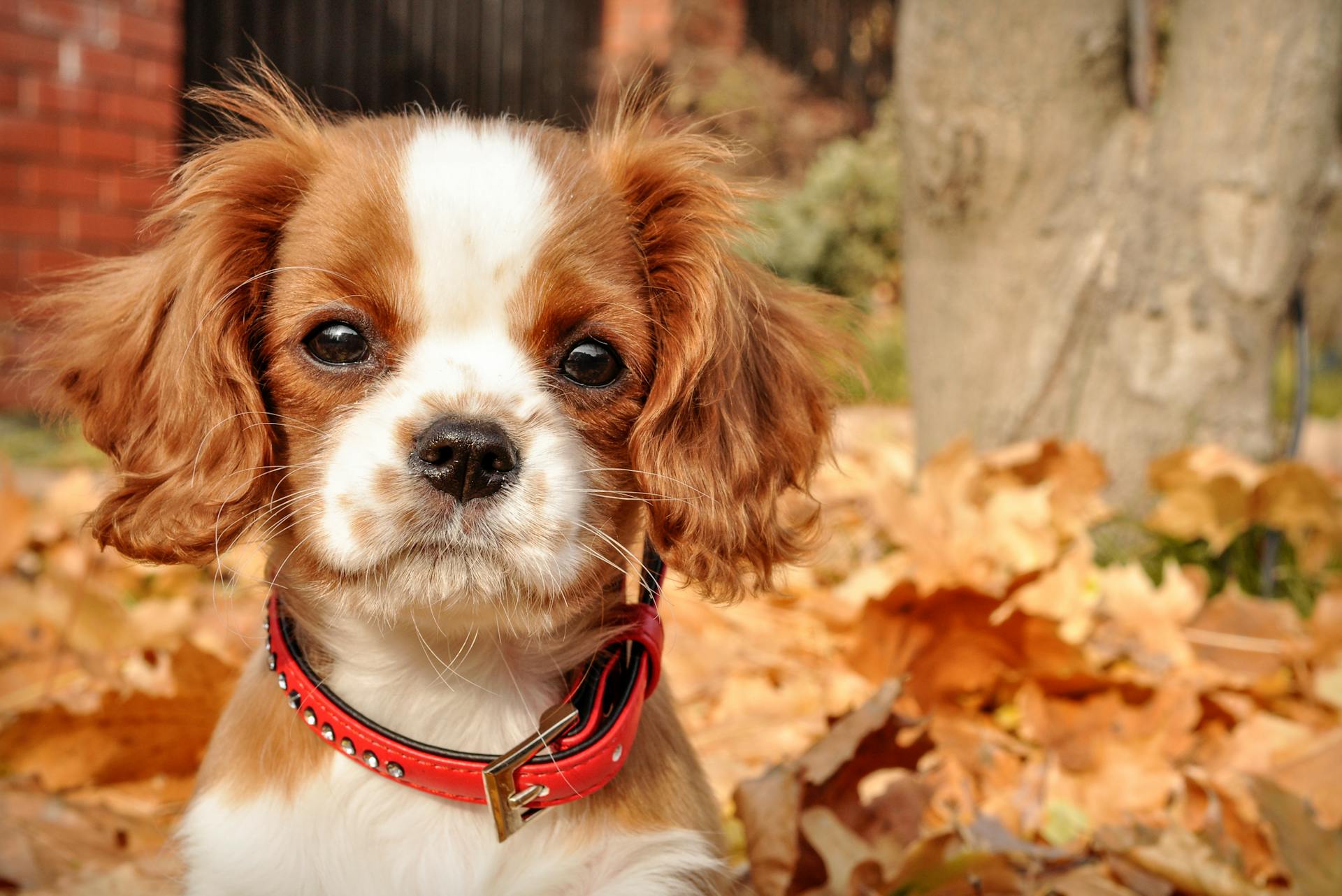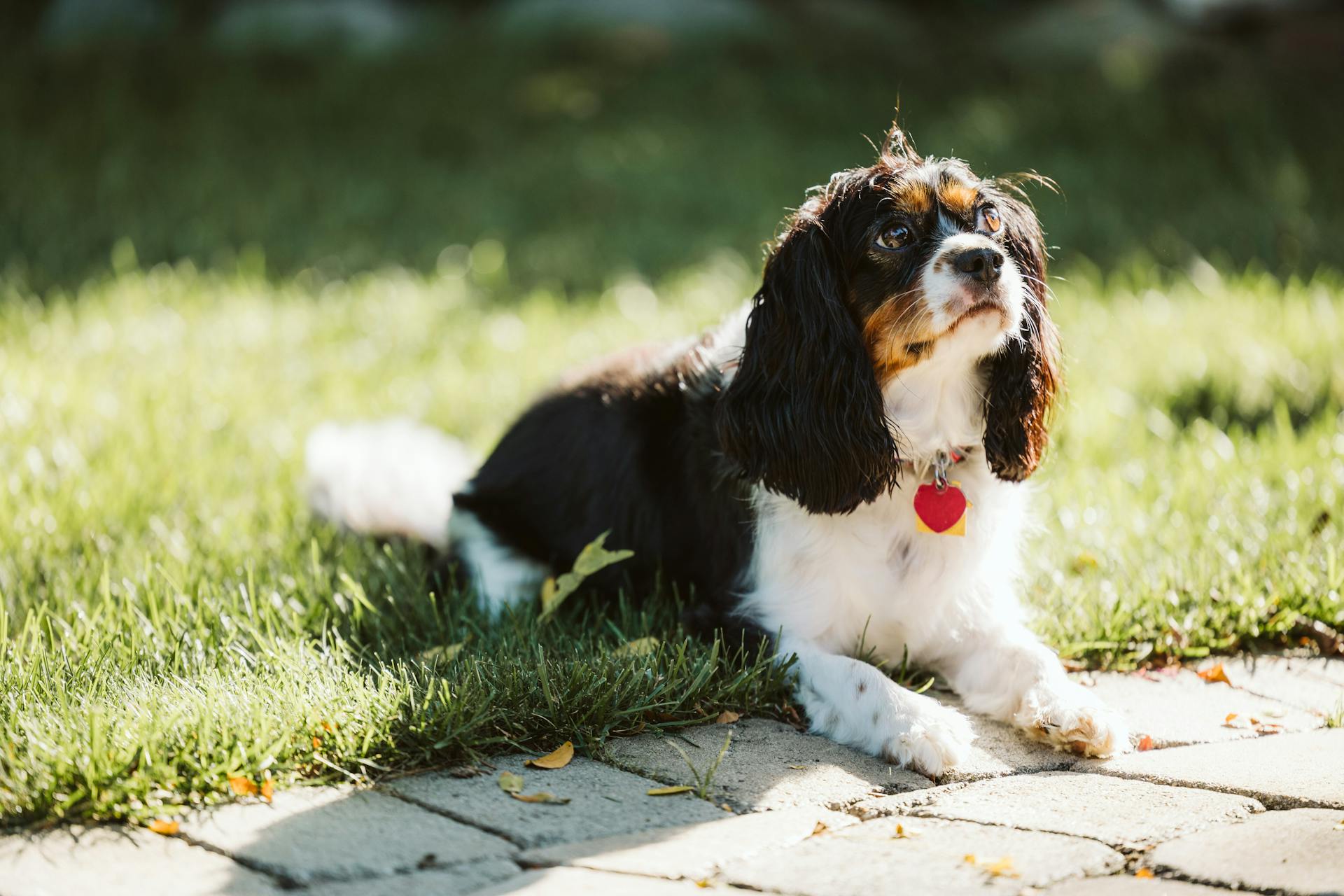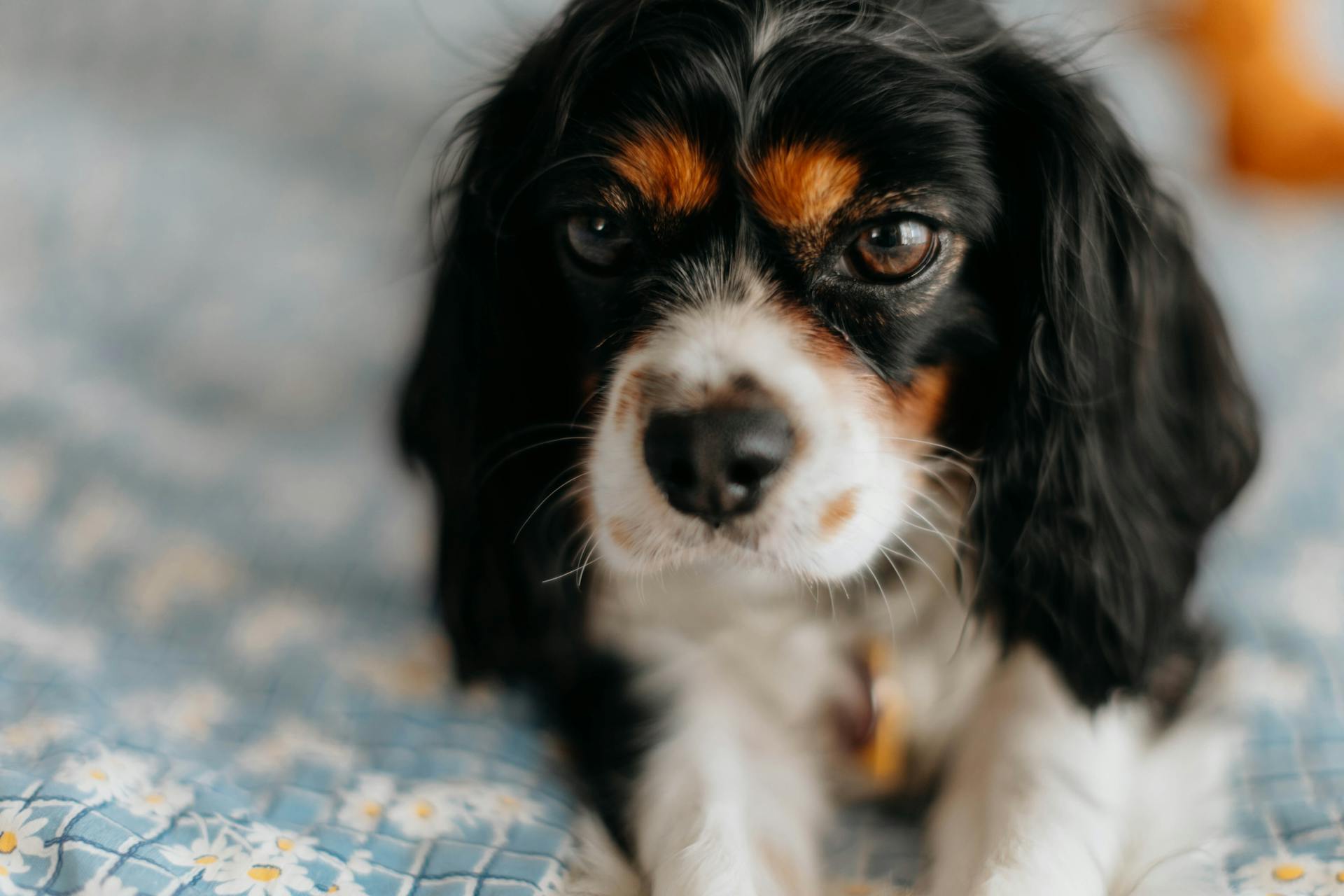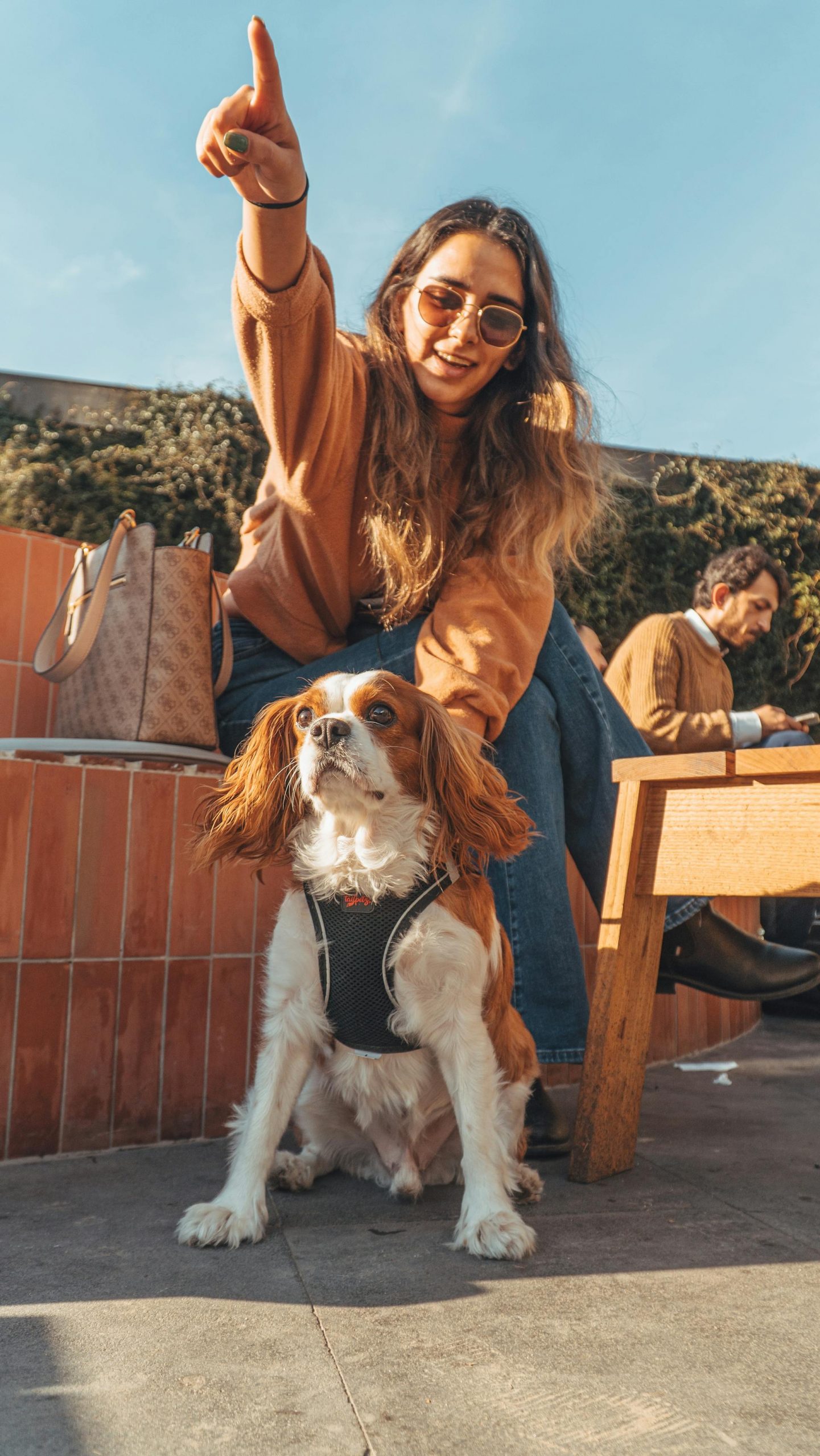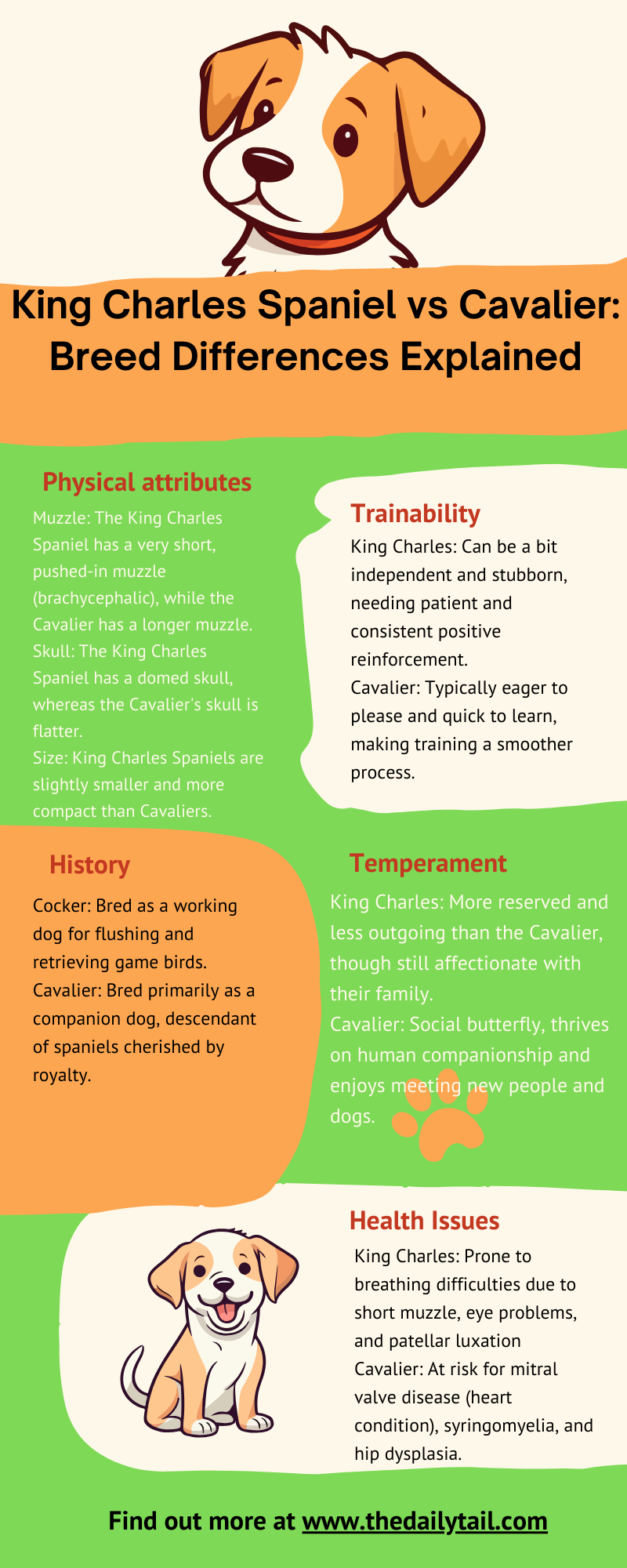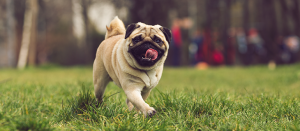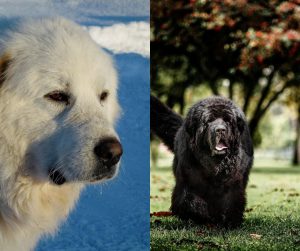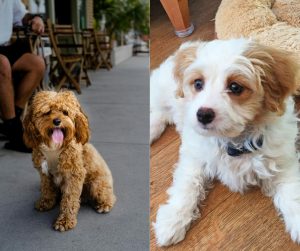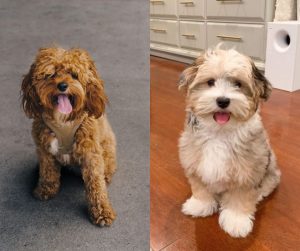From their subtle physical differences to their distinct personalities, the King Charles Spaniel and Cavalier King Charles Spaniel offer unique charms. As a dog owner who’s experienced both breeds, let me guide you through their differences and help you discover which one might capture your heart.
When discussing dog breeds, the King Charles Spaniel and the Cavalier King Charles Spaniel are often mentioned together, sometimes leading to confusion. While they might have similar names and share royal connections in their lineage, these are two distinct breeds with their own characteristics and histories.
The King Charles Spaniel, also known as the English Toy Spaniel, is a small breed developed in England, originally bred for companionship and as a lap dog. This breed is recognized by its shorter nose, domed skull, and overall smaller size compared to the Cavalier.
The Cavalier King Charles Spaniel, on the other hand, is slightly larger with a more pronounced muzzle and a flatter skull, reflecting its breeding for both companionship and sporting ability. This breed’s increased size, reaching 12 to 13 inches in height and 15 to 20 pounds in weight, allows for more physical activity and playfulness, a characteristic that differentiates it from the King Charles Spaniel.
Despite these differences, both breeds maintain a reputation for being affectionate, gentle companions that maintain a strong connection to their regal past.
Let’s take a look at the King Charles Spaniel vs Cavalier Spaniel.
Breed Origins and History
The King Charles Spaniel and the Cavalier King Charles Spaniel are two distinctive breeds, each with a rich history rooted in the royal courts of England. Their evolution has been influenced by the preferences of monarchs and the adherence to original breed standards over the centuries.
King Charles Spaniel Background
The King Charles Spaniel, originating in Great Britain, has been a recognized breed since before the time of Charles I and further popularized under Charles II. This toy spaniel became a favored companion in Scottish and English royal households, especially during the reign of Queen Mary I. Historical paintings and documents from this period often depict these small spaniels, establishing their presence in aristocratic circles.
Cavalier King Charles Spaniel Evolution
By the 1920s, the original appearance of the King Charles Spaniel began shifting due to crossbreeding with flatter-faced breeds. A group of dog enthusiasts, led by individuals such as the American Roswell Eldridge, sought to reestablish the breed’s initial conformation. The resulting breed was named the “Cavalier King Charles Spaniel” to differentiate it from the more altered “King Charles Spaniel,” and has since maintained the longer nose and less domed head reminiscent of the early toy spaniels.
Influence of Charles I and Charles II
King Charles I and Charles II of England were instrumental in the breed’s development. They were fervent admirers of small spaniels, cultivating the breed’s association with royalty. Charles II was so fond of his spaniels that he was rarely seen without them, leading to the decree that King Charles Spaniels be allowed in any public space, including the Houses of Parliament. This close association with the monarchy is what permanently linked the breed to the royal name.
Physical Characteristics
The King Charles Spaniel and the Cavalier King Charles Spaniel are both esteemed for their elegant and regal appearance, differing notably in size, build, and specific coat characteristics as set by their respective breed standards.
Size and Proportion
King Charles Spaniel:
- Height: Typically reaches 9 to 11 inches at the withers
- Weight: Generally weighs between 10 to 15 pounds
Cavalier King Charles Spaniel:
- Height: Slightly taller, ranging from 12 to 13 inches at the withers
- Weight: Heavier, with a weight range of 13 to 18 pounds
In terms of build, the King Charles Spaniel exhibits a more compact, square frame, while the Cavalier displays a proportionately longer body.
Coat and Colors
Both breeds have a luxurious coat, but they vary in texture and acceptable color patterns.
King Charles Spaniel:
- Coat: The coat is long, silky, and slightly wavy
- Colors: Recognized colors include black and tan, ruby, and Blenheim (chestnut and white)
Cavalier King Charles Spaniel:
- Coat: Also features a long, silky coat; however, it is known to be straighter than that of the King Charles
- Colors: Typical colors are black and tan, ruby, Blenheim, and tricolor (black/white/tan)
The two breeds share similar coat colors, but the specific tone and markings may differ. Breed standards for each stipulate the desired appearance and visual differences in greater detail, which is considered by breeders and enthusiasts.
Behavioral Traits
When exploring the differences between the King Charles Spaniel and the Cavalier King Charles Spaniel in terms of behavior, it’s essential to understand their temperaments and how they interact with other dogs. These aspects play a significant role in their suitability as pets in various households.
Temperament and Personality
King Charles Spaniel:
- Temperament: The King Charles Spaniel exhibits a sensitive and affectionate nature. They seek constant human companionship and thrive in environments where they receive ample attention
- Personality Traits: Despite their playful and mischievous demeanor, they may not be the best choice for families with small children. They tend to be an indoor breed, preferring the comforts of home over the outdoors
Cavalier King Charles Spaniel:
- Temperament: They are known for being sweet-tempered, sociable, and adaptable. These spaniels blend well into family life, often showing a well-balanced mix of loyal and affectionate behavior
- Personality Traits: The Cavalier is energetic and outgoing without being hyperactive. They are also less reserved and less stubborn than the King Charles Spaniel, typically displaying a gentle yet playful character
Interaction with Other Dogs
King Charles Spaniel:
- They may exhibit a reserved attitude towards other dogs initially, but with proper socialization, they can become more accepting and less anxious about interactions
- Their sensitivity requires careful introduction to other pets to avoid overwhelming them and to foster a positive behavior when they meet other dogs
Cavalier King Charles Spaniel:
- Generally, Cavaliers are very social with other dogs and can be considered family-friendly. They usually do not have issues interacting with other dogs and can be quite gregarious in such settings
- Their innate sports-minded character often makes them eager to engage in play, displaying a friendly and energetic attitude towards other dogs
Health and Lifespan
The health and lifespan of the King Charles Spaniel and the Cavalier King Charles Spaniel can vary due to innate breed-related health issues. Understanding these factors is crucial for potential owners to ensure proper care and management.
Common Health Issues
King Charles Spaniels and Cavalier King Charles Spaniels share susceptibility to certain health conditions, albeit with varying incidences. Both breeds can be prone to mitral valve disease (MVD), a serious heart condition where deterioration of the valve can lead to heart failure. This condition is notable as a leading cause of death, particularly in Cavaliers. Chiari malformation and syringomyelia are neurological conditions that are also common within these breeds, associated with the skull’s structure and potentially leading to discomfort or severe pain.
The list below outlines prevalent health issues for both breeds:
- Mitral Valve Disease: Progressive heart condition potentially resulting in heart failure
- Chiari Malformation/Syringomyelia: A skull and spinal cord condition that can cause pain and neurological problems
- Other health issues that can affect these breeds include eye conditions, hip dysplasia, and ear infections
Average Lifespan
The average lifespan can be a strong indicator of the overall health of a breed. King Charles Spaniels generally live between 9-14 years, contingent on factors such as genetics, environment, and level of care.
In comparison, Cavalier King Charles Spaniels exhibit a similar lifespan, influenced by the same factors as the King Charles Spaniel. It’s significant to note that while they share many health issues, the manifestation and impact of these issues can influence an individual dog’s quality of life and longevity. Lifelong care and timely veterinary attention can mitigate some health risks and may positively influence lifespan.
Care and Maintenance
Proper care and maintenance are vital for the health and happiness of both King Charles Spaniels and Cavalier King Charles Spaniels. Attention to grooming needs and adequate exercise will ensure these breeds lead a content and well-balanced life.
Grooming Needs
The King Charles Spaniel and the Cavalier King Charles Spaniel have distinct grooming requirements. They both have silky, medium-long coats that necessitate regular grooming to prevent mats and tangles.
- Brushing: Owners should brush their Spaniels multiple times a week
- King Charles Spaniel: Due to their longer coat, they may require more frequent brushing
- Cavalier King Charles Spaniel: Brushing a few times a week helps to manage their shedding
- Shedding: Both breeds experience shedding with seasonal peaks
- Cavaliers might shed more during spring and fall as they lose their winter and summer coats
Grooming is not just about maintaining appearances; it also helps to bond with the dog and check for any skin issues or parasites.
Exercise and Activities
Exercise is crucial to prevent obesity and to keep these dogs mentally stimulated and happy.
- Daily Walk: Owners should ensure a daily walk for both breeds to help them burn off energy
- Playful Activities: Ensuring interactive and playful activities strengthens their mental and physical well-being
- King Charles Spaniels are less active but still require play sessions
- Cavalier King Charles Spaniels are more energetic and appreciate longer or more vigorous playtimes
Recognizing each dog’s personality is important; some may be shy or prone to anxiety and require exercise that is tailored to their comfort level. Engaging activities can provide both breeds with a sense of purpose and satisfaction.
Training and Socialization
Both the King Charles Spaniel and the Cavalier King Charles Spaniel benefit from effective training and socialization practices. A well-structured approach ensures that they exhibit good behavior and are well-adjusted pets.
Training Techniques
King Charles Spaniel and Cavalier King Charles Spaniel are breeds known for their intelligence and eagerness to please, making them quite trainable. They respond best to positive reinforcement techniques, such as treats, praise, or playtime, which encourage cooperative behavior.
- Basic Obedience: It’s crucial to start with commands like sit, stay, come, and down to provide a foundation of obedience
- Consistent Training: Short, engaging, and regular training sessions help maintain attention and foster learning
- Canine Sports: For stimulation and exercise, sports like agility can be beneficial, provided that the activity is suited to their size and health
Importance of Socialization
Socialization is imperative for both breeds to promote confidence and reduce anxiety in various situations.
- Engage with other pets and people early on: A socialized spaniel is typically more outgoing and less prone to behavior issues
- Explore different environments: Exposure to diverse settings enhances adaptability and lessens fearfulness in unexpected scenarios
- Positive Experiences: Ensuring that new encounters are enjoyable supports the development of a sociable and well-behaved canine companion
When training and socializing King Charles Spaniels and Cavalier King Charles Spaniels, patience and positive interactions are key. Their trainability and predisposition for obedience can lead to a harmonious relationship between the spaniel and its owner.
Breed Comparisons
When discerning between the King Charles Spaniel and the Cavalier King Charles Spaniel, it’s important to note that they are two distinctive breeds recognized by various kennel clubs. Each possesses unique traits and falls under specific breed classifications that cater to enthusiasts of toy dog breeds.
Distinctive Traits
King Charles Spaniel:
- Height: 9 to 11 inches
- Weight: 10 to 15 pounds
- Physical Characteristics: Despite being a toy spaniel, the King Charles Spaniel, often referred to as the English Toy Spaniel in the United States, presents a more compact body and a distinguishably domed head
Cavalier King Charles Spaniel:
- Height: 12 to 13 inches
- Weight: 15 to 20 pounds
- Physical Characteristics: The Cavalier is slightly larger with an active, graceful demeanor. It has a flatter skull compared to the King Charles Spaniel and maintains a more athletic structure
Breed Classification
Both the King Charles Spaniel and the Cavalier King Charles Spaniel are recognized as individual breeds by prominent kennel clubs. Their categorization among kennel clubs is as follows:
- King Charles Spaniel:
- American Kennel Club (AKC): Classified under the Toy Group as the English Toy Spaniel
- The Kennel Club (UK): Listed as the King Charles Spaniel under the Toy Breed Group
- Cavalier King Charles Spaniel:
- American Kennel Club (AKC): Recognized within the Toy Group
- The Kennel Club (UK): Also classified under the Toy Group
While these breeds appear similar and share a common ancestry, the classification by kennel clubs emphasizes their status as separate breeds rather than variations of a singular type. This distinction further reflects in their breed standards that underline the physical and temperamental nuances differentiating them.
Adopting a Spaniel
When considering adopting a Spaniel, prospective pet owners should be attentive to breed-specific traits and personal lifestyle. The right match can provide a fulfilling companionship and a suitable pet for individuals or families.
Choosing the Right Breed
Size and Appearance: The King Charles Spaniel is often recognized by its shorter snout and a domed head. In contrast, the Cavalier King Charles Spaniel typically has a longer nose and flatter skull.
Temperament: While both breeds share an affectionate nature, the Cavalier is generally more energetic and playful, making it a vibrant companion for active individuals. On the other hand, the King Charles Spaniel may be more suitable for those seeking a laid-back pet.
Health Considerations: Cavaliers are notorious for certain genetic conditions, such as mitral valve disease, so owners should be prepared for potential long-term veterinary care.
Living with a King Charles or Cavalier
Family Dynamics: Both breeds can be excellent family dogs due to their gentle demeanor. They are also known to be companion dogs, often forming strong bonds with their owners.
Exercise Needs: Cavaliers require regular exercise to maintain their health and happiness. While King Charles Spaniels also enjoy a good stroll, their activity needs are usually less demanding.
Household Environment: A pet-friendly home for these breeds includes areas for play and rest. Comfortable bedding and access to toys can help them feel secure and entertained.
Training and Socialization: Early training and socialization are crucial for both breeds to foster good behavior and adaptability. They respond well to positive reinforcement and enjoy interactive play sessions.
By understanding the specific needs and characteristics of each breed, adopters can ensure a harmonious integration of their new pet into their home.
Historical and Cultural Impact
The historical and cultural impact of the King Charles Spaniel and the Cavalier King Charles Spaniel stretches back centuries, tied to royalty, and has woven into the fabric of canine evolution. These breeds have left a notable print on cultural references and the development of related breeds.
Popularity and Cultural References
The King Charles Spaniel, named after King Charles II of England, enjoyed immense popularity during the 17th century. Charles II was so fond of his spaniels that they were said to accompany him everywhere, creating a strong association between the breed and English royalty. This royal affinity led the breed to often be featured in paintings and artwork of the era, securing a place in cultural history.
The Cavalier King Charles Spaniel, although a direct descendant, gained prominence later. This breed has been a fixture in various forms of media, from literature to television, often symbolizing luxury and nobility due to its royal ties.
Descendants and Related Breeds
The two breeds, through history, have been influenced by other toy breeds such as the Pug, Pekingese, and Japanese Chin. This interbreeding was particularly noted in the King Charles Spaniel, leading to the development of its shorter snout.
Descendants and related breeds have emerged over time, with the Cavalier King Charles Spaniel itself being a product of an effort to rebreed the old-type King Charles Spaniel, which has resulted in the distinction we observe today. The Cavalier has also contributed genetically to other breeds, promoting a legacy of spaniel-like dogs with even temperaments and sociable natures.
They are also related to the Cocker Spaniel and American Cocker Spaniel.

